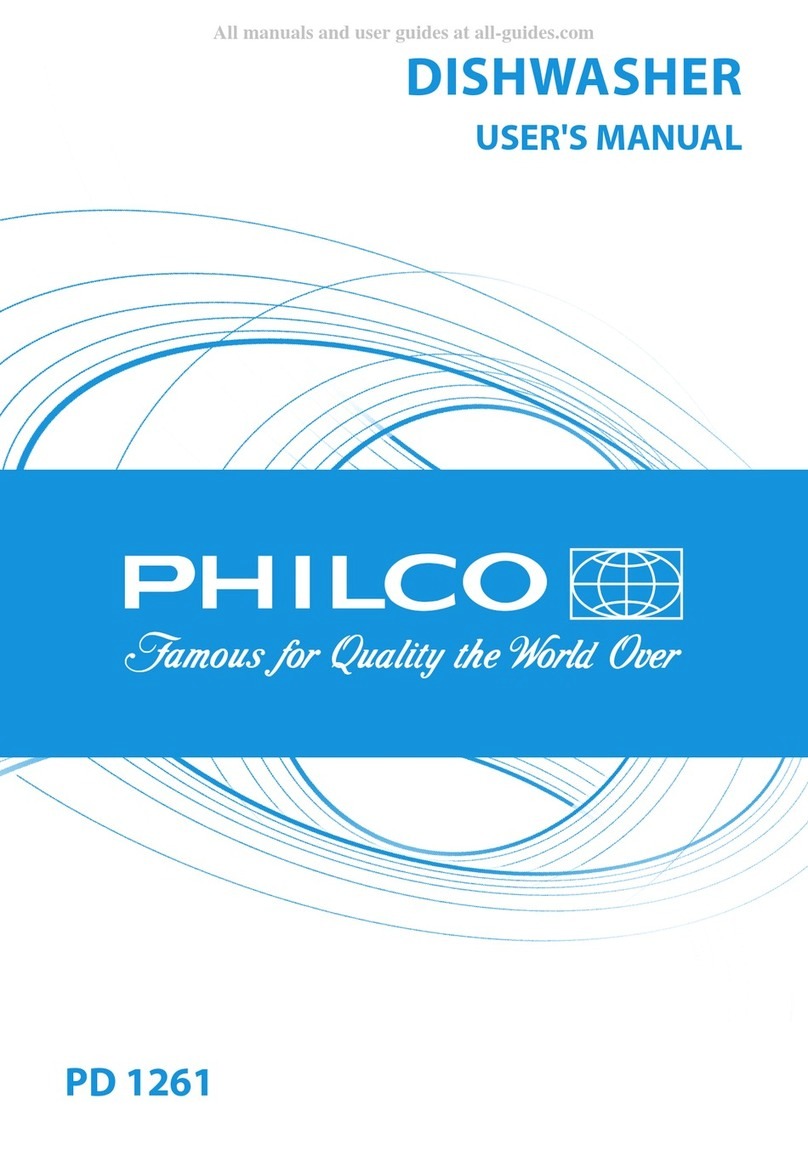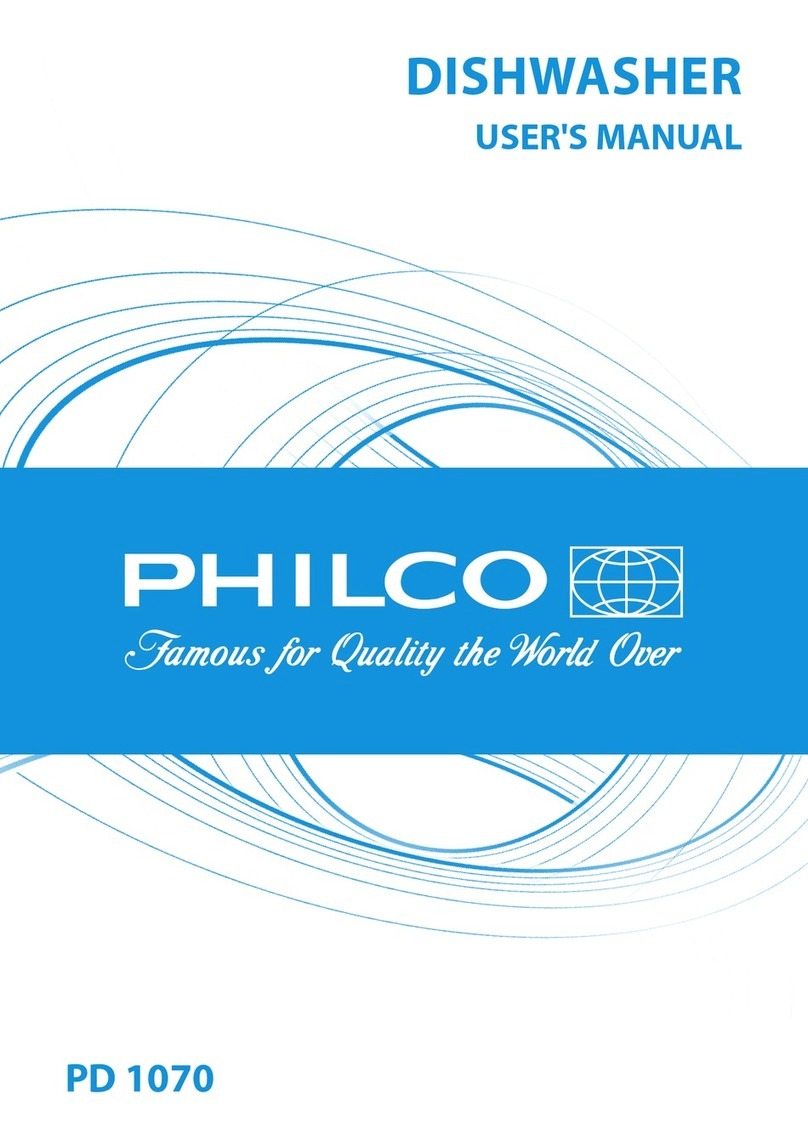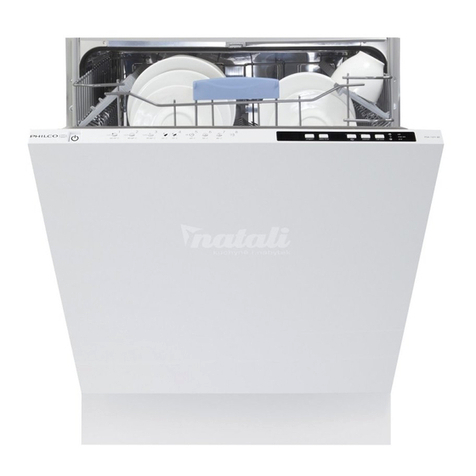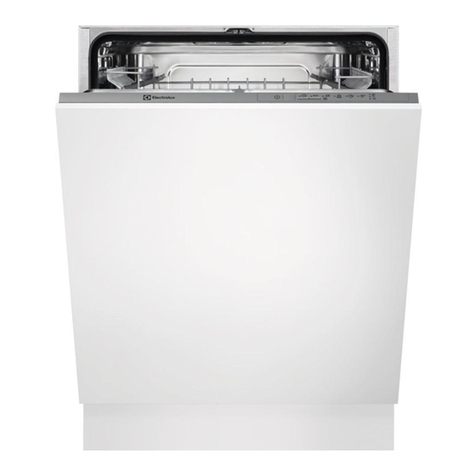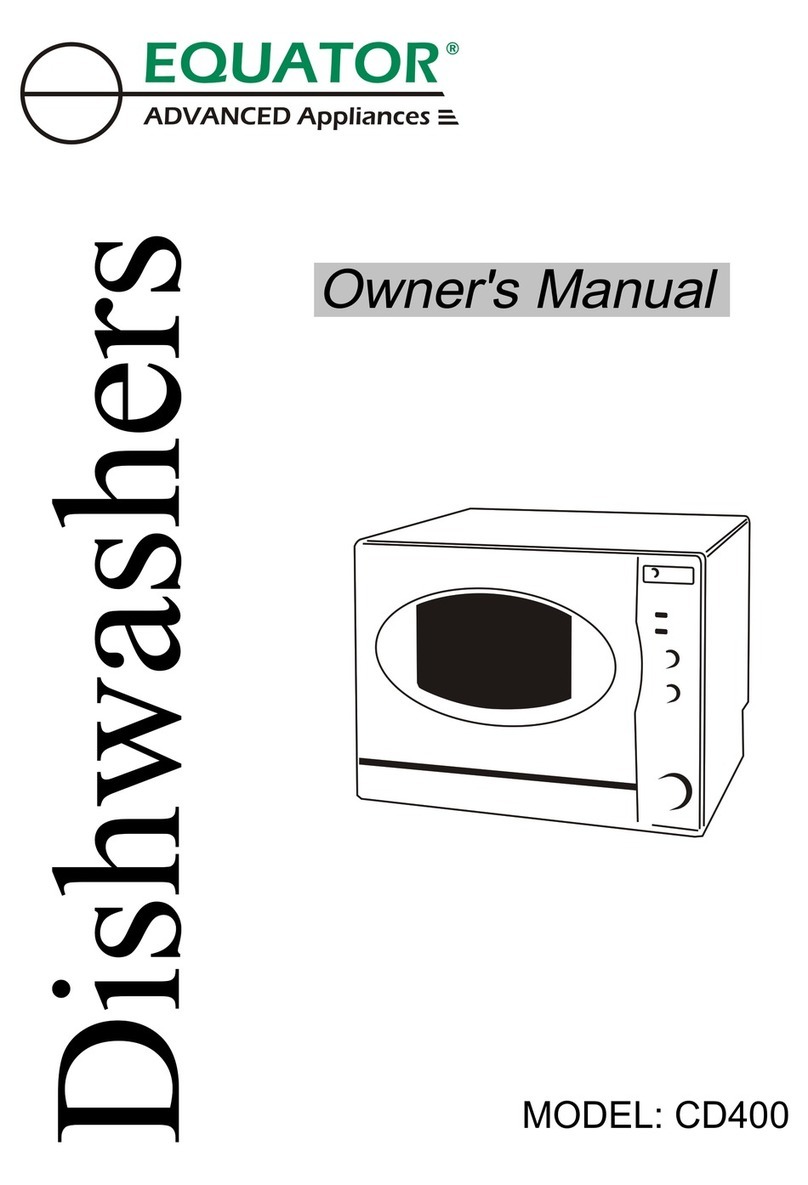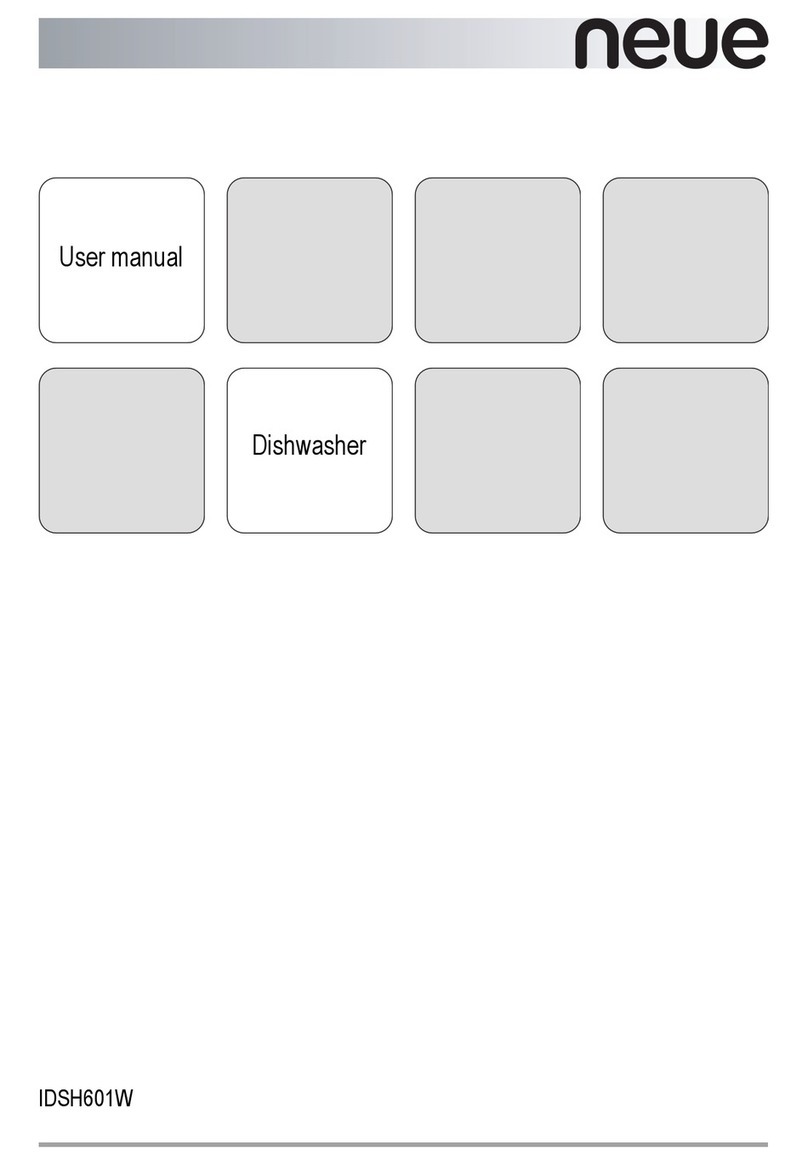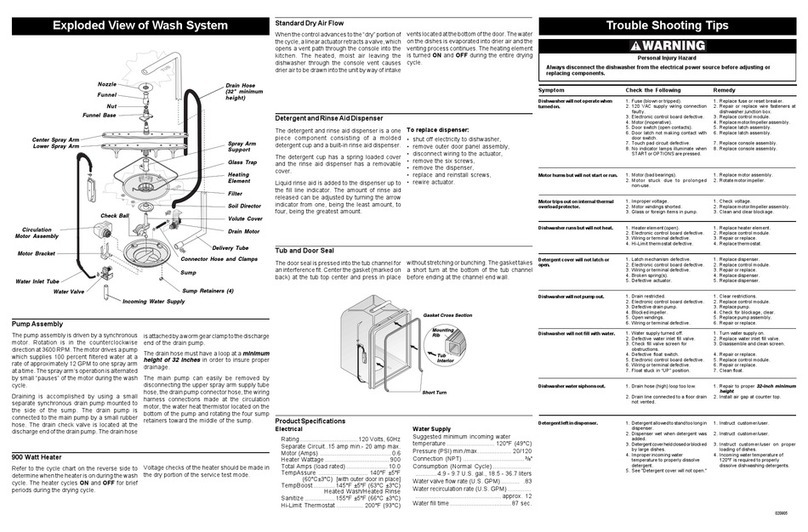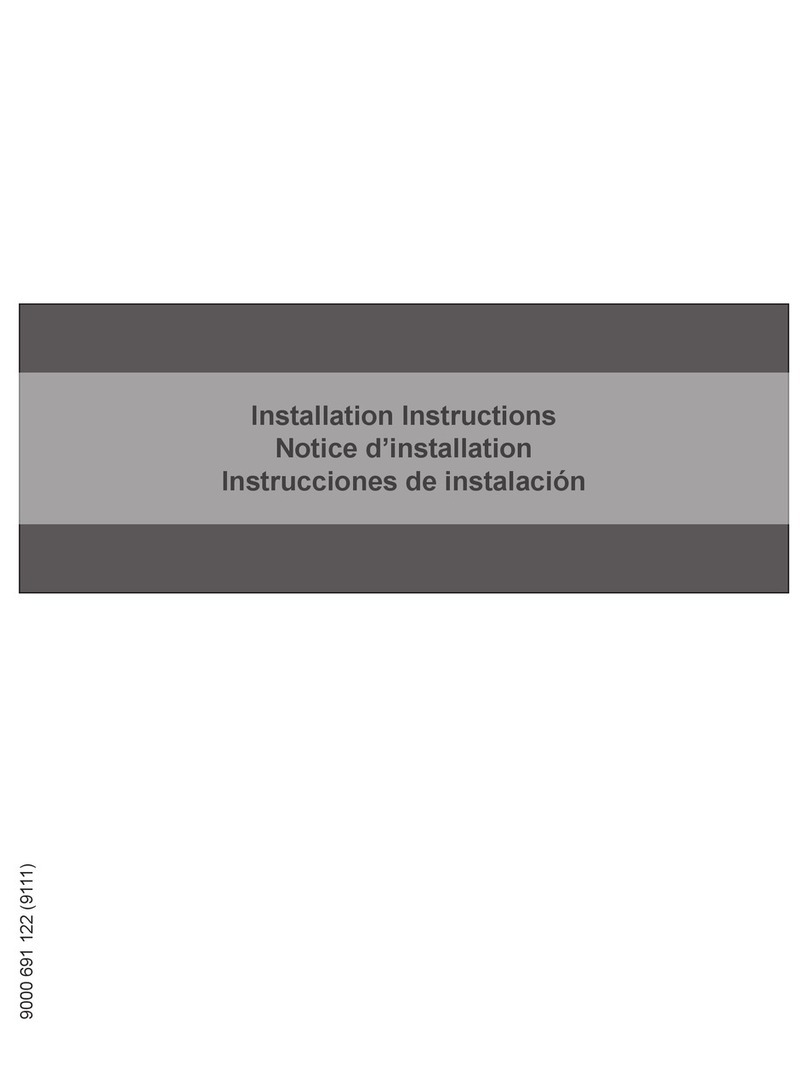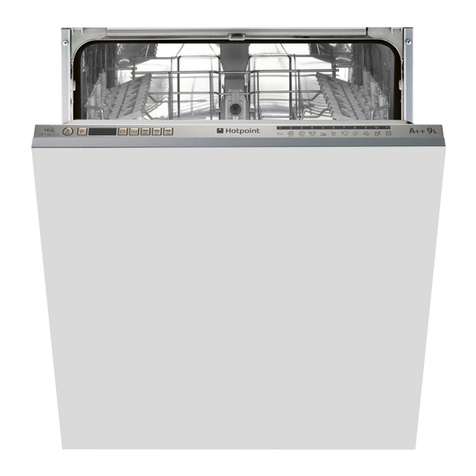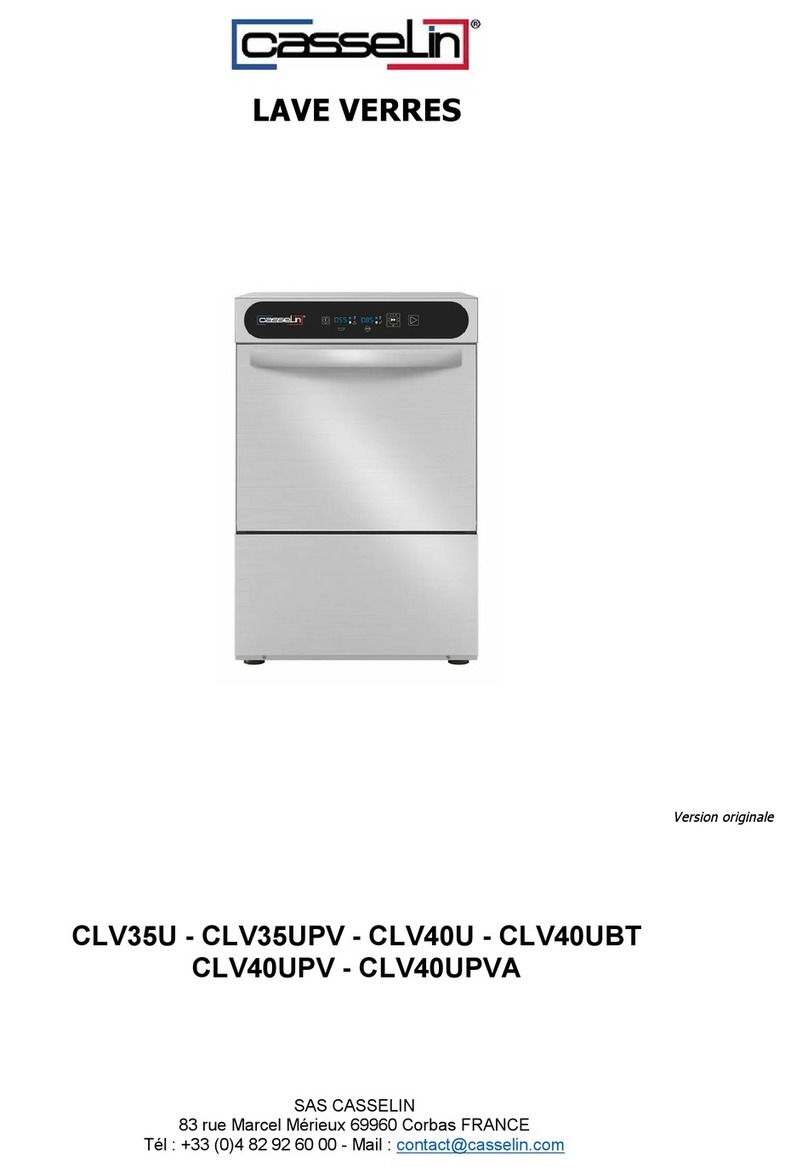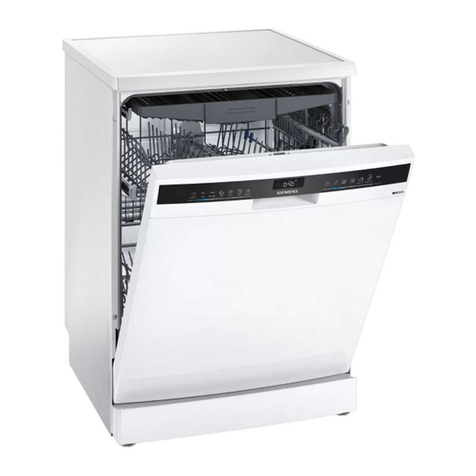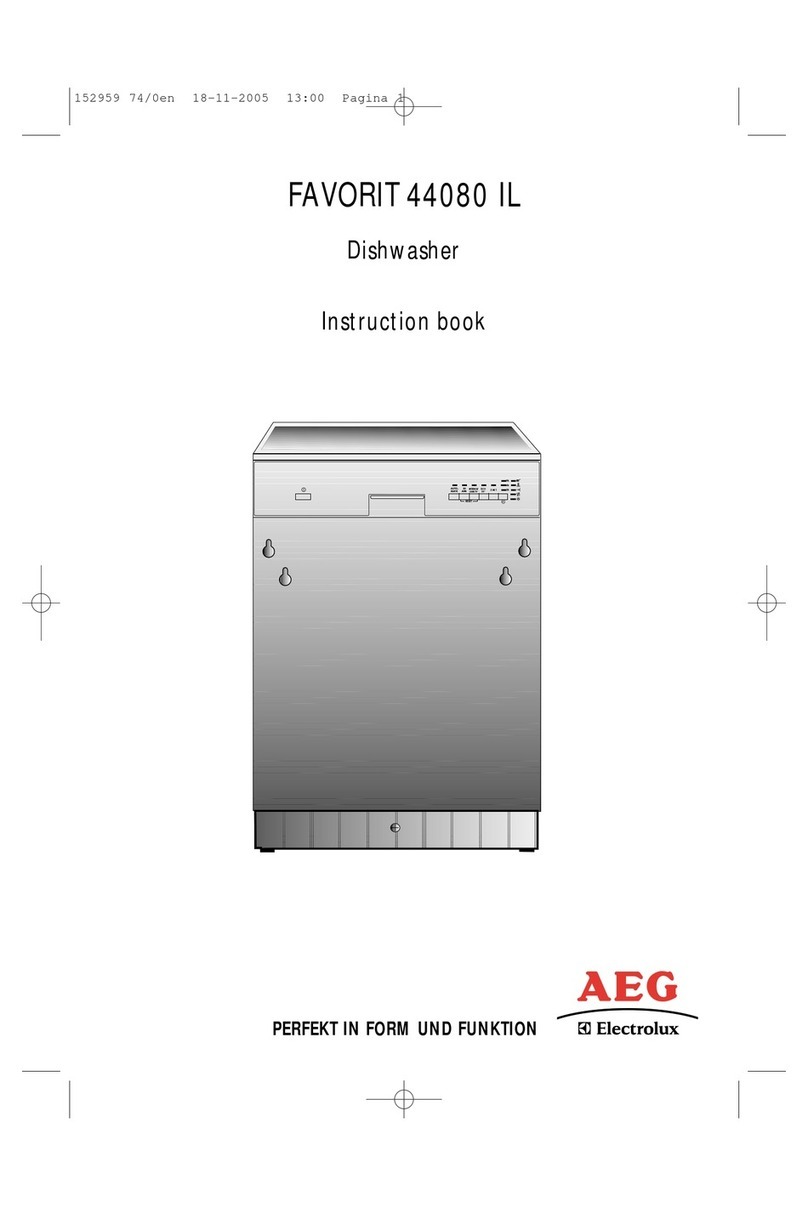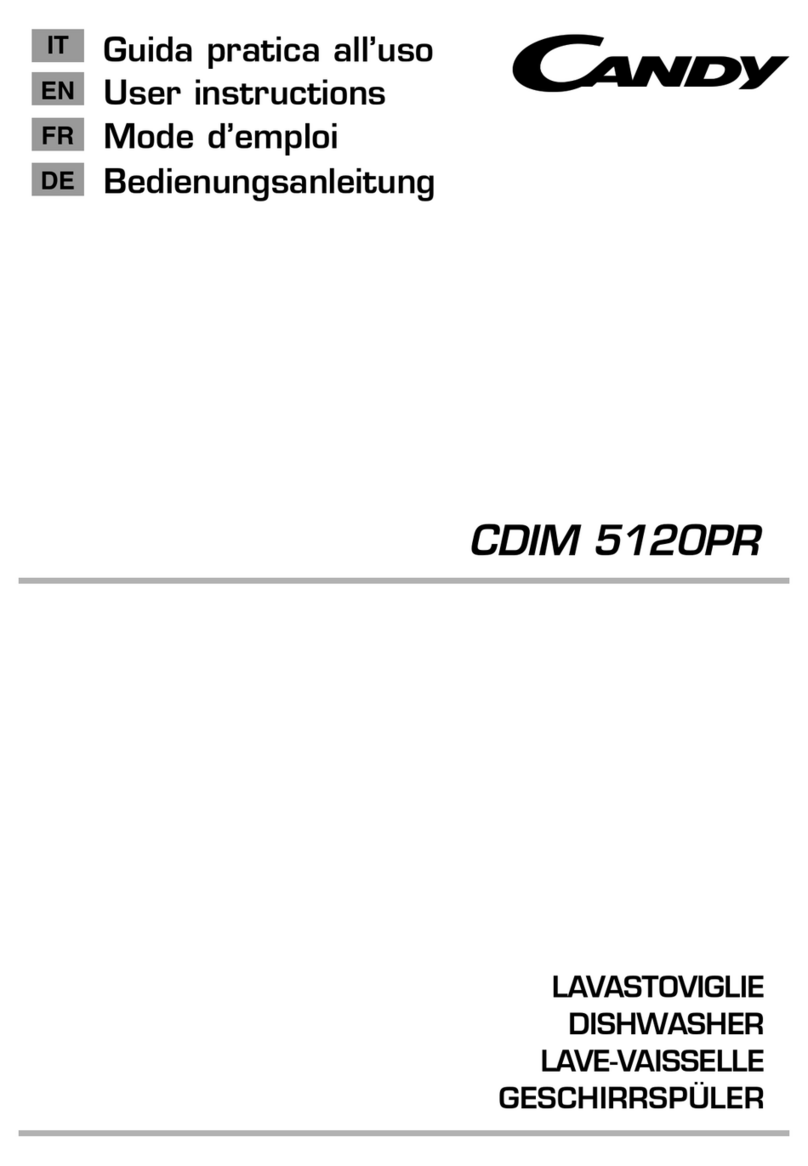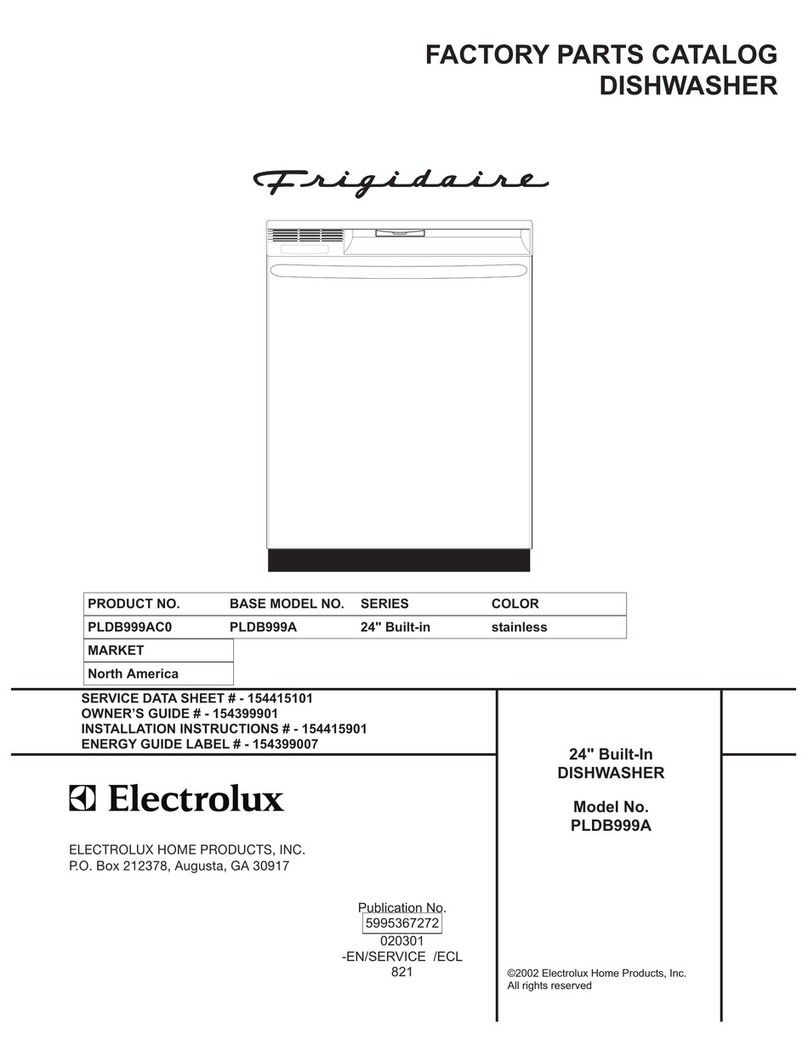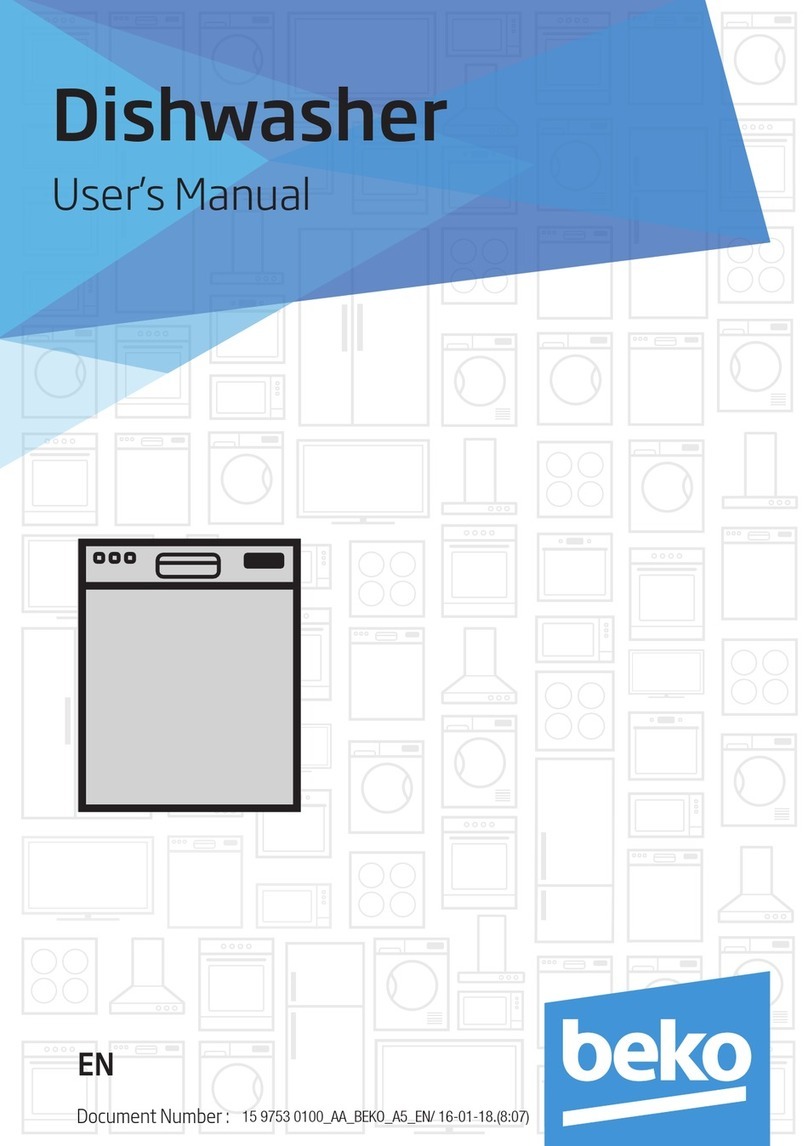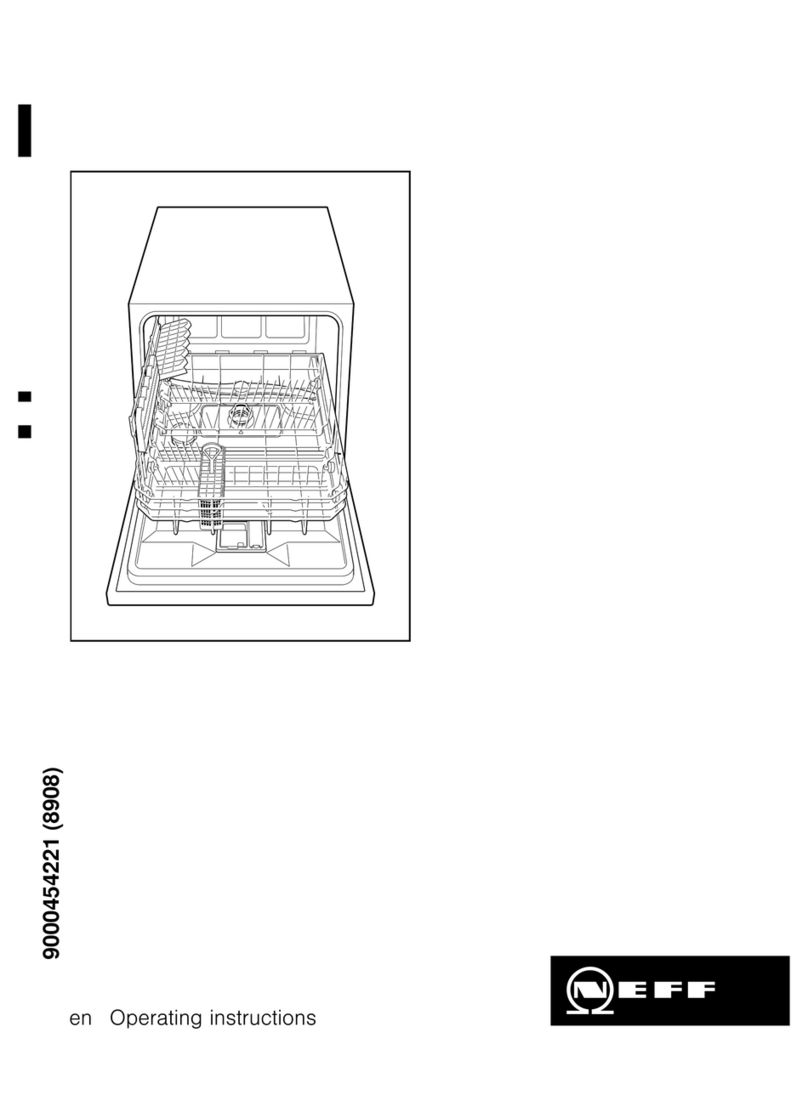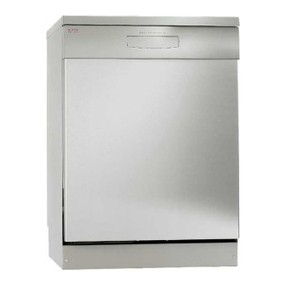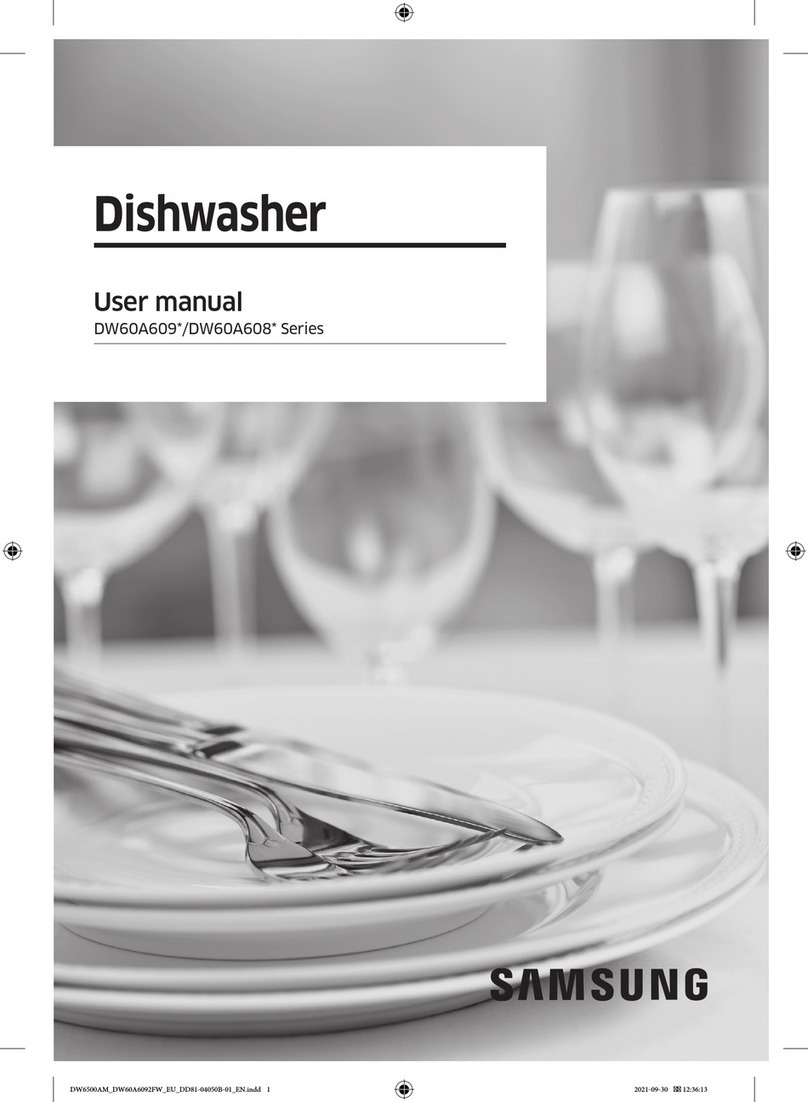Philco PDA 1482 BiT User manual

DISWASHER
USER´S MANUAL
PDA 1482 BiT

Dear customer,
Thank you for buying aPHILCO brand product. So that your appliance serves you well, please read all
the instructions in this user’smanual.

EN - 1
01/2016Copyright © 2016, Fast ČR, a. s.
PART 1: BEFORE PUTTING INTO OPERATION................................................................................................. 2
PART 2: TECHNICAL SPECIFICATIONS AND INFORMATION SHEET............................................................... 7
PART 3: DEVICE DESCRIPTION ........................................................................................................................ 9
• Dishwasher description................................................................................................................................................................9
• Control panel....................................................................................................................................................................................9
PART 4: QUICK START GUIDE ........................................................................................................................ 10
PART 5: PRIOR USING FOR THE FIRSTTIME.................................................................................................. 11
• Water Softener.............................................................................................................................................................................. 11
• Adjusting salt consumption.....................................................................................................................................................11
• Loading the salt into the softener ......................................................................................................................................... 12
• Fill the rinse aid dispenser........................................................................................................................................................ 13
• Function of detergent................................................................................................................................................................ 14
• Detergents...................................................................................................................................................................................... 15
• Fill in Detergent............................................................................................................................................................................ 16
PART 6: LOADING THE DISHWASHER ........................................................................................................... 17
PART 7: STARTING THE DISHWASHER .......................................................................................................... 23
• Wash program chart...................................................................................................................................................................23
• Turning on the appliance.......................................................................................................................................................... 24
• Changing the program..............................................................................................................................................................24
• At the end of the wash cycle ...................................................................................................................................................25
PART 8: CLEANING AND MAINTENANCE...................................................................................................... 26
• Filtering system ............................................................................................................................................................................ 26
• Caring of the dishwasher.......................................................................................................................................................... 27
• Cleaning the door........................................................................................................................................................................27
• Protect Against Freezing........................................................................................................................................................... 28
• Cleaning the Spray Arms...........................................................................................................................................................28
• How to keep your dishwasher in shape............................................................................................................................... 28
PART 9: INSTALLATION INSTRUCTION ......................................................................................................... 30
• Installation preparation............................................................................................................................................................. 30
• Aesthetic panel’sdimensions and installation..................................................................................................................31
• Connection of drain hoses .......................................................................................................................................................33
• Dishwasher installation steps.................................................................................................................................................. 34
• Power connection........................................................................................................................................................................ 35
• Electrical Requirements............................................................................................................................................................. 35
• Cold water connection .............................................................................................................................................................. 36
• Positioning of the appliance.................................................................................................................................................... 36
• Start of dishwasher ..................................................................................................................................................................... 37
PART 10: TROUBLESHOOTING GUIDE .......................................................................................................... 38
CONTENT

EN - 2
01/2016Copyright © 2016, Fast ČR, a. s.
PART 1: BEFORE PUTTING INTO OPERATION
•
Please carefully read this user’smanual before putting this dishwash-
er into operation - it will help you to use and maintain it correctly.
• Store it for future reference.
• Hand it over to any future owner of this appliance.
• This user’smanual includes sections with safety instructions, op-
erating instructions, installation instructions and troubleshoot-
ing tips, etc.
• The section Troubleshooting tips will help you solve certain
non-complicated problems yourself.
• If you are not successful in solving the problem, contact aprofes-
sional technician for help.
• Due to continuous product development and modernisation, the
manufacturer may perform modications without prior notice.
• This user’smanual is also available from the manufacturer or are-
liable retailer.
Important safety instructions
WARNING!
When using your dishwasher, follow the precautions listed
below:
• This appliance is intended to be used only in household.

EN - 3
01/2016Copyright © 2016, Fast ČR, a. s.
• This appliance can be used by children aged from 8 years and
above and persons with reduced physical, sensory or mental
capabilities or lack of experience and knowledge if they have been
given supervision or instruction concerning use of the appliance
in asafe way and understand the hazards involved. Children shall
not play with the appliance. Cleaning and user maintenance shall
not be made by children without supervision.
• This appliance is for indoor use only, for household use only.
• To protect against the risk of electrical shock, do not immerse the
unit, cord or plug in water or other liquid.
• Please unplug before cleaning and maintenance the appliance.
• Use asoft cloth moisten with mild soap, and then use adry cloth
to wipe it again.
EARTHING INSTRUCTIONS
• This appliance must be earthed. In the event of a malfunction
or breakdown, earthing will reduce the risk of anelectric shock
by providing a path of least resistance of electric current. This
appliance is equipped with acord having an equipment-earthing
conductor and agrounding plug.
• The plug must be plugged into an appropriate outlet that is
installed and earthed in accordance with all local codes and
ordinances.
• Improper connection of the equipment-earthing conductor can
result in the risk of an electric shock.
• Check with aqualied electrician or service representative if you
are in doubt whether the appliance is properly grounded.
• Do not modify the plug provided with the appliance; if it does not
t the outlet.
• Have aproper outlet installed by aqualied electrician.

EN - 4
01/2016Copyright © 2016, Fast ČR, a. s.
• Do not abuse, sit on, or stand on the door or dish rack of the
dishwasher.
• Do not operate your dishwasher unless all enclosure panels are
properly in place.
• Open the door very carefully if the dishwasher is operating, there
is arisk of water squirting out.
• Do not place any heavy objects on or stand on the door when it is
open. The appliance could tip forward.
• When loading items to be washed:
1) Locate sharp items so that they are not likely to damage the
door seal;
2) Warning: Knives and other utensils with sharp points must
be loaded in the basket with their points down or placed in
ahorizontal position.
• Check that the detergent powder is empty after completion of
the wash cycle.
• Do not wash plastic items unless they are marked dishwasher
safe or the equivalent.
• For plastic items not so marked, check the manufacturer’s
recommendations.
• Use only detergent and rinse additives designed for an automatic
dishwasher.
• Never use soap, laundry detergent, or hand washing detergent in
your dishwasher.
• Children should be supervised to ensure that they do not play
with the appliance.
• The door should not be left open, since this could increase the
risk of tripping.
• If the supply cord is damaged, it must be replaced by the
manufacturer or its service agent or asimilarly qualied person in
order to avoid ahazard.

EN - 5
01/2016Copyright © 2016, Fast ČR, a. s.
• During installation, the power supply must not be excessively or
dangerously bent or attened.
• Do not tamper with controls.
• The appliance is to be connected to the water mains using new
hose sets and that old hose-sets should not be reused.
• The maximum number of place settings to be washed is 14.
• The maximum permissible inlet water pressure is 1MPa.
• The minimum permissible inlet water pressure is 0.04MPa.
Disposal
• Dispose of the dishwasher packaging material correctly.
• All packaging materials can be recycled.
• Plastic parts are marked with the standard international
abbreviations:
PE for polyethylene, e.g. sheet wrapping material
PS for polystyrene, e.g. padding material
POM polyoxymethylene, e.g. plastic clips
PP polypropylene, e.g. Salt ller
ABS Acrylonitrile Butadiene Styrene, e.g. Control Panel.
WARNING!
Packaging material could be dangerous for children!
For disposing of package and the appliance please go to arecycling
centre. Therefore cut o the power supply cable and make the door
closing device unusable.
Cardboard packaging is manufactured from recycled paper and
should be disposed in the waste paper collection for recycling.
By ensuring this product is disposed of correctly, you will help
prevent potential negative consequences for the environment and
human health, which could otherwise be caused by inappropriate

EN - 6
01/2016Copyright © 2016, Fast ČR, a. s.
waste handling of this product.
For more detailed information about recycling of this product,
please contact your local city oce and your household waste
disposal service.
DISPOSAL: Do not dispose this product as unsorted municipal
waste. Collection of such waste separately for special treatment is
necessary.

EN - 7
01/2016Copyright © 2016, Fast ČR, a. s.
PART 2: TECHNICAL SPECIFICATIONS
ANDINFORMATION SHEET
Technical Information
Height (cm) 81.5
Width (cm) 59.8
Depth with connectors (cm) 55
Power consumption 1930 W
Rated voltage / frequency 230 V~ / 50 Hz
Water pressure 0.4-10 bar = 0.04-1 Mpa
Information Sheet
INFORMATION SHEET: Philco
Philco brand:
Name Philco
Model identication number PDA 1482 BiT
Nominal capacity (Sets of dishes) 14
Power eciency class (scale from A+++ as most ecient to D as least ecient) A++
Annual power consumption (AE C) in kWh per year at 280 cycles * (kWh) 266
Power consumption (Et) per standard wash cycle (kWh) 0.93
Power consumption when power is o (W)(Po) 0.45
Power consumption when power is on (W)(PI) 0.49
Annual water consumption (AWC) in litres per year ** 2800
Drying eciency class (scale from Awith the highest eciency to G with the lowest
eciency) A
Standard program *** Eco 45 °C
Program duration for standard wash cycle in minutes 195
Noise level (dB(A) re 1 pW) **** 45
Built-in appliance ano
* The annual power consumption of 266 kWh is based on 280 standard wash cycles, with cold water at the
inlet and operation in the low power consumption modes. Actual power consumption will depend on
how the appliance is used.
** The annual water consumption of 2800 litres is based on 280 standard wash cycles. Actual water
consumption will depend on how the appliance is used.
*** “Eco 45 °C” is the standard wash cycle to which the information provided on the rating label and in the
information list relates. This program is suitable for washing standard soiled tableware and it is the most
eective program in terms of combined power and water consumption.
**** The declared noise emission level of the appliance represents aweighted level of sound power Lw relative
to the reference sound power of 1 pW.
The above provided data may change without prior notice.

EN - 8
01/2016Copyright © 2016, Fast ČR, a. s.
The original version is in the Czech language.
The manufacturer reserves the right to change the design and technical specications without prior notice.
Compliance with standards and test data / EC statement of compliance
All phases connected with the appliance are performed in accordance with the safety directive issued in all
relevant directives of the European Community. 2004/108/EC, 2006/95/EC, IEC 436/DIN 44990, EN50242.

EN - 9
01/2016Copyright © 2016, Fast ČR, a. s.
PART 3: DEVICE DESCRIPTION
Dishwasher description
Front view Back view
1
2
3
4
5
7
6
8
9
10
1Top spray arm 4Inner pipe 7Dispenser q; Filter assembly
2Cutlery rack 5Lower basket 8Cup shelf qa Inlet pipe connector
3Upper basket 6Salt container 9Spray arms qs Drain pipe
Control panel
Alt
1. Display screen: to show the error code, delay time
etc.
• Rinse Aid indicator:
Indicates when the dispenser needs to be
relled.
• Add salt indicator:
Indicates when the dispenser needs to be
relled.
• Delay time or error codes indicator:
• Program indicators:
• Zone wash indicator:
• Extra drying indicators:
2. Extra drying function choose Button: To choose
Extra drying function.
Note: only Intensive, Normal, ECO, Glass, 90min
programs have extra drying function.
3. Alt Button: Dual zone wash function, press the
button to select either upper basket or lower
basket loaded and the response indicator will
light.
4. Delay Button: To press the button to delay.
5. Program Button: To press the button to select
awash Program.
6. On/o Button: To turn on/o the power supply.
NOTE:
This drawing is intended for information purposes about the individual parts and accessories of
the product. Individual parts may dier depending on the model.

EN - 10
01/2016Copyright © 2016, Fast ČR, a. s.
PART 4: QUICK START GUIDE
For detailed operating method read the corresponding content on the instruction manual.
Switch on the appliance. Open the door, press the On/O button to switch on the appliance.
Fill the detergent
dispenser.
Compartment A:
With each wash cycle.
Compartment B:
For programmes with pre-wash only. (Follow the user instructions!)
Check the rinse aid level. Mechanical indicator C.
Electric indicator on control panel (if provided).
Check the regeneration
salt level.
(On models with water softener system only.) Electric indicator on control
panel (if provided). If there is no salt warning light in the control panel
(for some models), you can estimate when to ll the salt into the softener
by the number of cycles the dishwasher has run.
Load the baskets. Scrape o any large amount of leftover food. Soften remnants of burnt food in pans, then
load the baskets. Refer to the dishwasher loading instructions.
Select aprogramme. Press the Programme Button until the selected programme lights up. ( See the section
entitled“Operation instruction”)
Running the dishwasher. Turn on the water tap, close the door. The machine will star t working after about 10 seconds.
●Changing the
programme.
●1. Arunning cycle can only be modied if it has been running for ashort time. Otherwise
the detergent may have already been released and the water already drain ed. If this is
the case, the detergent dispenser must be relled.
2. Open the door.
3. Press the Program button for more than 3 seconds
to cancel the running programme.
4. Select anew programme.
5. Restart the dishwasher.
●Add forgotten dishes in
the dishwasher.
●1. Open the door alittle to stop the dishwasher.
2. After the spray arms stop working, you can open the
door completely.
3. Add the forgotten dishes.
4. Close the door, the dishwasher will start running again after 10 seconds.
●If the appliance is
switched o during
awash cycle.
●If the appliance is switched o during awash cycle, when switched on again, please re-
select the washing cycle and operate the dishwasher according to the original Power-on
state).
Switch o the appliance
When the working cycle has nished, the buzzer of the dishwasher will sound 8 times, then
stop.
Turn o the appliance using the On/O Button.
Turn o the water tap,
unload the baskets
Warning: wait afew minutes (about 15 minutes) before unloading the dishwasher to avoid
handling the dishes and utensils while they are still hot and more susceptible to break.
They will also dry better. Unload the appliance, starting from the lower basket.
WARNING!
Open the door carefully.
Hot steam may escape
when the door is opened!

EN - 11
01/2016Copyright © 2016, Fast ČR, a. s.
PART 5: PRIOR USING FOR THE FIRST TIME
Before using your dishwasher for the rst time:
– Set the water softener
– Add 1.5Kg dishwasher salt and then full ll the salt container with water
– Fill the rinse aid dispenser
– Fill in detergent
Water Softener
The water softener must be set manually, using the water hardness dial.
The water softener is designed to remove minerals and salts from the water, which would have adetrimental
or adverse eect on the operation of the appliance.
The higher the content of these minerals and salts, the harder your water is.
The softener should be adjusted according to the hardness of the water in your area.Your local Water Authority
can advise you on the hardness of the water in your area.
Adjusting salt consumption
The dishwasher is designed to allow for adjustment in the amount of salt consumed based on the hardness of
the water used. This is intended to optimise and customise the level of salt consumption.
Please follow the steps below for adjustment in salt consumption
1. Open the door, switch on the appliance;
2. Press the Program button for more than 5 seconds to start the water softener set model within
60seconds after the appliance was switched on( The Salt and Rinse aid warning lights will be on
periodically when it get in the set model );
3. Press the Program button to select the proper set according to your local environment, the sets will
change in the following sequence: H1 →H2 →H3 →H4 →H5 →H6;
4. Press the Power button to end the set up model.
Water hardness Selector position Salt consumption
(g/cycle)
°dH °fH °Clarke mmol/l
0 ~ 5 0 ~ 9 0 ~ 6 0 ~ 0,94 Selector position 0
6-11 10-20 7-14 1,0-2,0 H2 (90 Min light bright) 9
12-17 21-30 15-21 2,1-3,0 H3 (90 Min, Rapid light bright) 12
18-22 31-40 22-28 3,1-4,0 H4 (Eco light bright) 20
23-34 41-60 29-42 4,1-6,0 H5 (Eco, Rapid light bright) 30
35-55 61-98 43-69 6,1-9,8 H6 (Eco, 90 Min light bright) 60
NOTE:
1 dH = 1,25 Clarke = 1,78 fH = 0,178 mmol/l
DH: German degree
fH: French degree
Clark: British degree
The manufactory setting: H3 (EN 50242)
Contact your local water board for information on the hardness of your water supply.

EN - 12
01/2016Copyright © 2016, Fast ČR, a. s.
NOTE:
If your model does not have any water softener, you may skip this section.
WATER SOFTENER
The hardness of the water varies from place to place. If hard water is used in the dishwasher, deposits will form
on the dishes and utensils.
The appliance is equipped with aspecial softener that uses asalt container specically designed to eliminate
lime and minerals from the water.
Loading the salt into the softener
Always use the salt intended for use with dishwasher.
The salt container is located beneath the lower basket and should be lled as explained in the following:
ATTENTION!
– Only use salt specically designed for the use in dishwashers! Every other type of salt not
specically designed for the use in adishwasher, especially table salt, will damage the water
softener. In case of damages caused by the use of unsuitable salt the manufacturer does not
give any warranty nor is liable for any damages caused.
– Only ll with salt just before starting one of the complete washing programs.
– This will prevent any grain of salt or salty water, which may have been spilled, remaining on
the bottom of the machine for any period of time, which may cause corrosion.
Open
AAfter the lower basket has been removed, unscrew and remove the cap from the salt container – see
picture 1.
BPlace the end of the funnel (supplied) into the hole and introduce about 1.5k g of dishwasher salt.
CFull ll the salt container with water; it is normal for asmall amount of water to come out of the salt
container – see picture 2.
DAfter lling the container, screw the cap tightly back clockwise.
EThe salt warning light will stop being after the salt container has been lled with salt.
FImmediately after lling the salt into the salt container, awashing program should be started program.
Otherwise the lter system, pump or other important parts of the machine may be damaged by salty
water. This is out of warranty.
NOTES:
1. The salt container must only be relled when the salt warning light in the control panel
comes on. Depending on how well the salt dissolves, the salt warning light may still be on
even though the salt container is lled. If there is no salt warning light in the control panel
(for some Models), you can estimate when to ll the salt into the softener by the cycles that
the dishwasher has run.
2.
If there are spills of the salt, asoak or arapid program should be run to remove the excessive salt.

EN - 13
01/2016Copyright © 2016, Fast ČR, a. s.
Fill the rinse aid dispenser
Rinse Aid Dispenser
The rinse aid is released during the nal rinse to prevent water from forming droplets on your dishes, which
can leave spots and streaks. It also improves drying by allowing water to roll o the dishes. Your dishwasher
is designed to use liquid rinse aids. The rinse aid dispenser is located inside the door next to the detergent
dispenser.
To ll the dispenser, open the cap and pour the rinse aid into the dispenser until the level indicator turns
completely black. The volume of the rinse aid container is about 110ml.
Function of Rinse Aid
Rinse aid is automatically added during the last rinse, ensuring thorough rinsing, and spot and streak free
drying.
ATTENTION!
Only use branded rinse aid f or dishwasher. Never ll the rinse aid dispenser with any other
substances (e.g. Dishwasher cleaning agent, liquid detergent).This would damage the appliance.
When to Rell the Rinse Aid Dispenser
If there is no rinse-aid warning light in the control panel, you can estimate the amount from the colour of the
optical level indicator C located next to the cap. When the rinse-aid container is full, the whole indicator will
be dark .As the rinse-aid diminishes, the size of the dark dot decreases. You should never let the rinse aid level
fall 1 / 4 full.
As the rinse aid diminishes, the size of the black dot on the rinse aid level indicator changes, as illustrated
below.
Full
3 / 4 full
1 / 2 full
1 / 4 full - Should rell to eliminate spotting
Empty
1 To open the dispenser, turn the cap to the “open”(left) arrow and lift it out.
2 Pour the rinse aid into the dispenser, being careful not to over ll.
3 Replace the cap by inserting it aligned with“open”arrow and turning it to the closed (right) arrow.
C (Rinse-Aid indicator)

EN - 14
01/2016Copyright © 2016, Fast ČR, a. s.
NOTE:
Clean up any rinse aid spilled while during lling with an absorbent cloth to avoid excessive
foaming during the next wash. Don’t forget to replace the cap before you close dishwasher door.
Adjusting Rinse Aid Dispenser
The rinse aid dispenser has six or four settings. Always start
with the dispenser set on “4”. If s pots and poor drying are
a problem, increase the amount of rinse aid dispensed by
removing the dispenser lid and rotating the dial to “5”. If the
dishes still are not drying properly or are show spots, adjust
the dial to the next higher lever until your dishes are spot-free.
The recommended setting is“4”. (Factor yvalue is“4”.)
(Hodnota nastavená výrobcem je„4“.)
NOTE:
Increase the dose if there are drops of water or lime spots on the dishes after washing. Reduce it if
there are sticky whitish stains on your dishes or abluish lm on glassware or knife blades.
Function of detergent
Detergents with its chemical ingredients are necessary to remove dirt, crush dirt and transport it out of the
dishwasher.
Most of the commercial quality detergents are suitable for this purpose.
ATTENTION!
Proper Use of Detergent
Use only detergent specically made for the use in dishwashers. Keep your detergent fresh and
dry.
Don’t put powdered detergent into the dispenser until you’re ready to wash dishes.
Detergents
There are 3 sorts of detergents
1. With phosphate and with chlorine
2. With phosphate and without chlorine
3. Without phosphate and without chlorine
Normally new pulverised detergent is without phosphate. Thus the water softener function of phosphate is not
given. In this case we recommend to ll salt in the salt container even when the hardness of water is only 6dH.
If detergents without phosphate are used in the case of hard water often white spots appear on dishes and
glasses. In this case please add more detergent to reach better results. Detergents without chlorine do only
bleach alittle. Strong and coloured spots will not be removed completely. In this case please choose aprogram
with ahigher temperature.
Concentrated Detergent
Based on their chemical composition, detergents can be split in two basic types:
– conventional, alkaline detergents with caustic components
– low alkaline concentrated detergents with natural enzymes
Adjust lever (Rinse)

EN - 15
01/2016Copyright © 2016, Fast ČR, a. s.
Detergent Tablets
Detergent tablets of dierent brands dissolve at dierent speeds. For this reason some detergent tablets
cannot dissolve and develop their full cleaning power during short programs. Therefore please use long
programs when using detergent tablets, to ensure the complete removal of detergent residuals.
Detergent Dispenser
The dispenser must be relled before the start of each wash cycle following the instructions provided in the
wash cycle table. Your dishwasher uses less detergent and rinse aid than Conventional dishwasher. Generally,
only one tablespoon of detergent is needed for anormal wash load. More heavily soiled items need more
detergent. Always add the detergent just before starting the dishwasher, otherwise it could get damp and will
not dissolve properly.
Amount of detergent to use
Press latch to open
Detergent powder
Detergent tablet
NOTE:
You nd information about the amount of detergent for the single programme on the last page.
Please aware, that according to the level soiling and the specic hardness of water dierences
are possible.
Please observe the manufacturer’srecommendations on the detergent packaging.
WARNING!
Mycí prostředek do myček je korozivní! Uchovávejte jej mimo dosah dětí.
Fill in Detergent
Fill the detergent dispenser with detergent. The marking indicates the dosing
levels, as illustrated on the right:
AThe place of main wash cycle detergent placed.
BThe place of pre-wash cycle detergent placed.
Please observe the manufacturers dosing and storage
Recommendations as stated on the detergent packaging.
Close the lid and press until it locks in place.

EN - 16
01/2016Copyright © 2016, Fast ČR, a. s.
If the dishes are heavily soiled, place an additional detergent dose in the pre-wash detergent chamber. This
detergent will take eect during the pre-wash phase.
NOTE:
●You nd information about the amount of detergent for the single programme on the last
page.
●Please aware, that according to the level soiling and the specic hardness of water dierences
are possible.
●Please observe the manufacturer’srecommendations on the detergent packaging.
Close the Detergent compartment
If your dishes are only moderately dirty, you may be able to use less
detergent than recommended.
– Detergent compartment.
Press down the lid (1) until it clicks shut (2).
– If you are using detergent in tablet form, read the manufacturer
recommendations on the packaging in order to determine where the
tablets should be placed inside the dishwasher (e.g. in cutlery basket,
detergent compartment, etc.).
Make sure that the lid on the detergent compartment is closed, even if
you are using tablets.

EN - 17
01/2016Copyright © 2016, Fast ČR, a. s.
PART 6: LOADING THE DISHWASHER
Recommendation
●Consider buying utensils which are identied as dishwasher-proof.
●Use amild detergent that is described as ‘kind to dishes’. If necessary, seek further information from the
detergent manufacturers.
●For particular items, select aprogram with as low atemperature as possible.
●To prevent damage, do not take glass and cutlery out of the dishwasher immediately after the programme
has ended.
Washing the following cutlery / dishes in the dish
Not suitable
●Cutlery with wooden, horn china or mother-of-
pearl handles
●Plastic items that are not heat resistant
●Older cutlery with glued parts that are not
temperature resistant
●Bonded cutlery items or dishes
●Pewter or cooper items
●Crystal glass
●Steel items subject to rusting
●Wooden platters
●Items made from synthetic bres
Limited suitability
●Some types of glasses can become dull after
alarge number of washes
●Silver and aluminium parts have a tendency to
discolour during washing
●Glazed patterns may fade if machine washed
frequently
Attention before and after loading the baskets
For best performance of the dishwasher, follow these loading guidelines.
Features and appearance of baskets and cutlery baskets may vary from your model.
Scrape o any large amounts of leftover food.
Soften remnants of burnt food in pans. It is not necessary to rinse the dishes under running water.
Place objects in the dishwasher in following way:
1. Items such as cups, glasses, pots/pans, etc. are faced downwards.
2. Curved items, or ones with recesses, should be loaded aslant so that water can run o.
3. All utensils are stacked securely and cannot tip over.
4. All utensils are placed in the way that the spray arms can rotate freely during washing.

EN - 18
01/2016Copyright © 2016, Fast ČR, a. s.
NOTE:
Very small items should not be washed in the dishwasher as they could easily fall out of the
basket.
– Load hollow items such as cups, glasses, pans etc. With the opening facing downwards so
that water cannot collect in the container or adeep base.
– Dishes and items of cutlery must not lie inside one another, or cover each other.
– To avoid damage to glasses, they must not touch.
– Load large items which are most dicult to clean into the lower basket.
– The upper basket is designed to hold more delicate and lighter dishware such as glasses,
coee and tea cups
– Long bladed knives stored in an upright position are apotential hazard!
– Long and/or sharp items of cutlery such as carving knives must be positioned horizontally in
the upper basket.
– Please do not overload your dishwasher. This is important for good results and for reasonable
consumption of energy.
Removing the dishes
To prevent water dripping from the upper basket into the lower basket, we recommend that you empty the
lower basket rst and then the upper basket.
The loading method of normal dishware
Loading the upper basket
The upper basket is designed to hold more delicate
and lighter dishware such as glasses, coee and
tea cups and saucers, as well as plates, small bowls
and shallow pans (as long as they are not too dirty).
Position the dishes and cookware so that they will
not get moved by the spray of water.
Loading the lower basket
We suggest that you place large items and the most
dicult to clean items are to be placed into the lower
basket: such as pots, pans, lids, serving dishes and
bowls, as shown in the gure below. It is preferable
to place serving dishes and lids on the side of the
racks in order to avoid blocking the rotation of the
top spray arm.
IN IN
Please be reminded that:
– Pots, serving bowls, etc, must always be placed top down.
– Deep pots should be slanted to allow water to ow out.
– The Bottom Basket features folding spikes so that larger or more pots and pans can be loaded.
Table of contents
Other Philco Dishwasher manuals
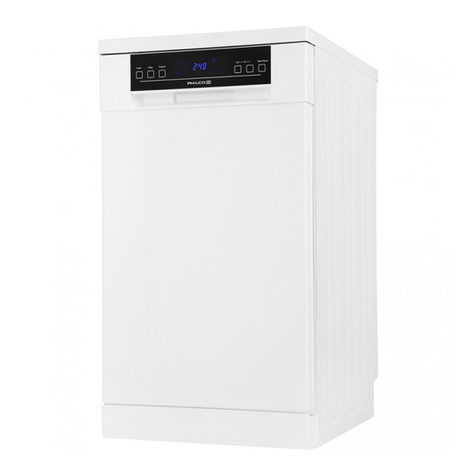
Philco
Philco PDP 4 WH User manual
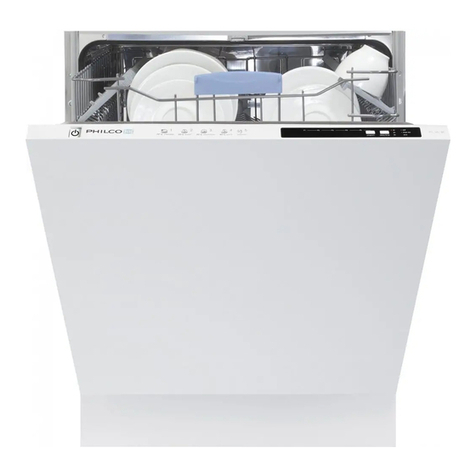
Philco
Philco PD 1251 BiT User manual

Philco
Philco PD 1080 User manual
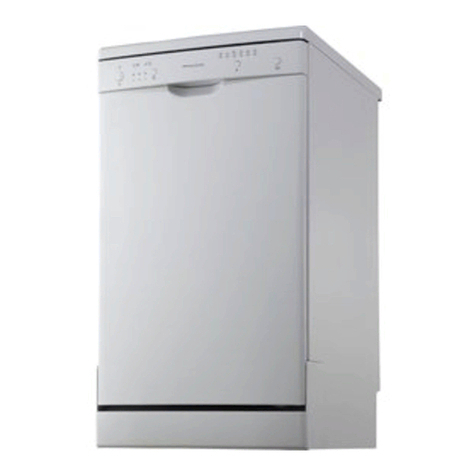
Philco
Philco PD 860 User manual
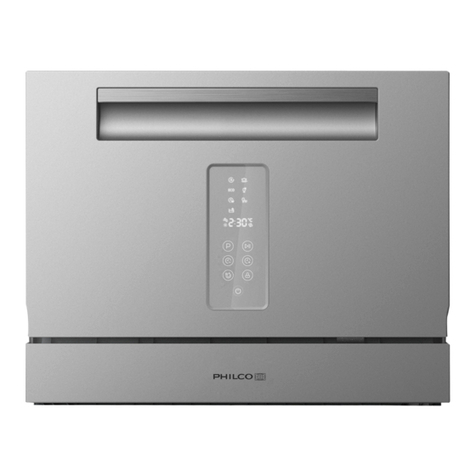
Philco
Philco PDT 67 DF User manual

Philco
Philco PDI 1568 DT User manual
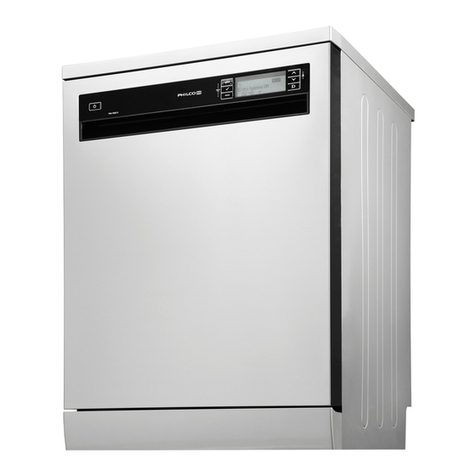
Philco
Philco PDA 15103 X User manual

Philco
Philco PDA 870 User manual
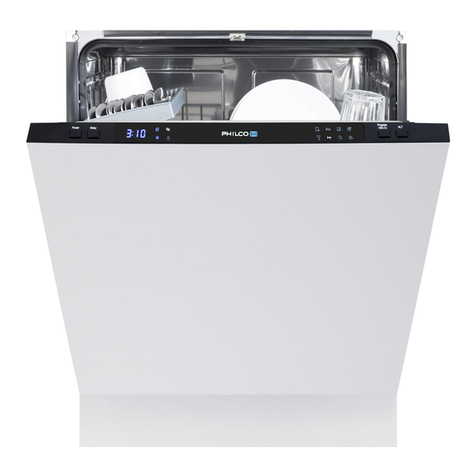
Philco
Philco PD 1273 BiT User manual
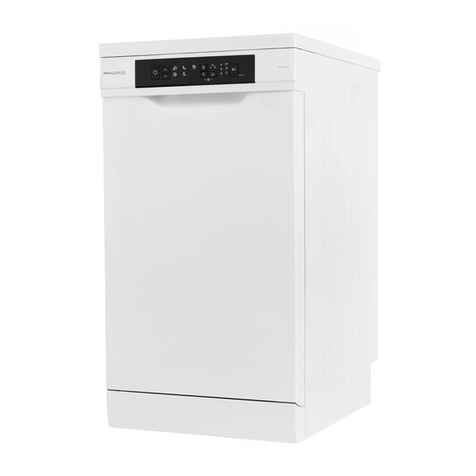
Philco
Philco PD 1045 EA User manual
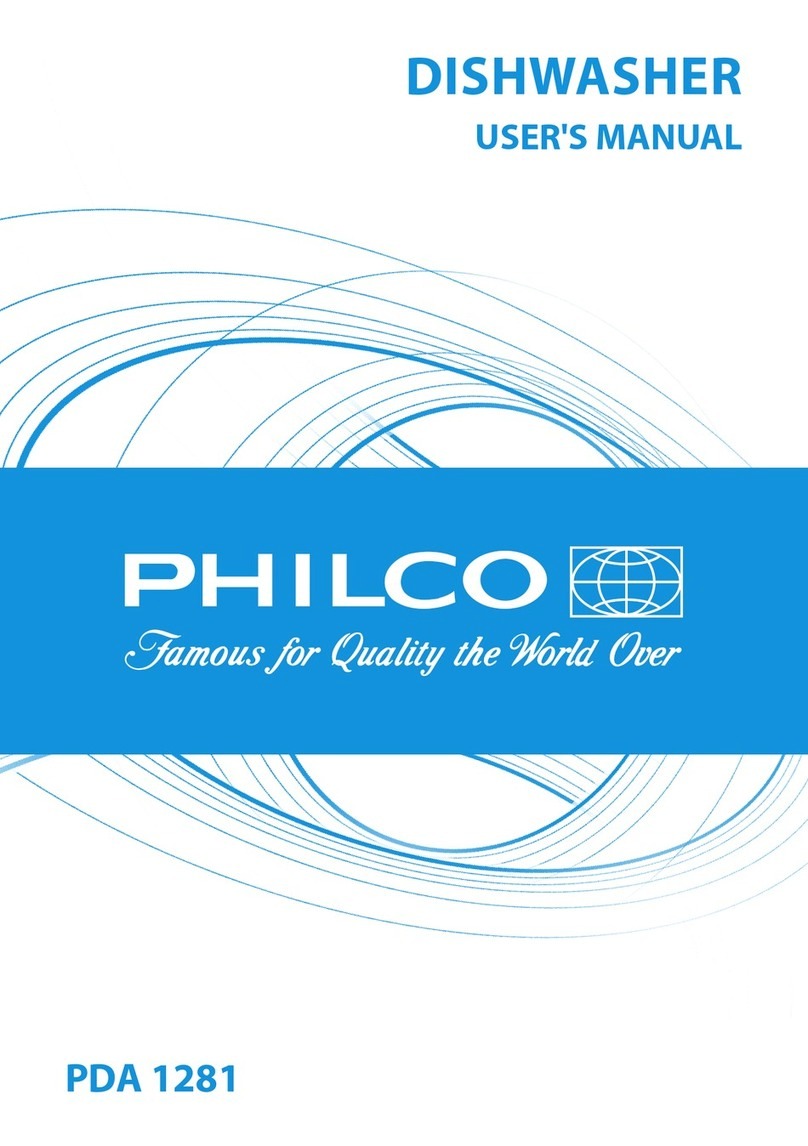
Philco
Philco PDA 1281 User manual
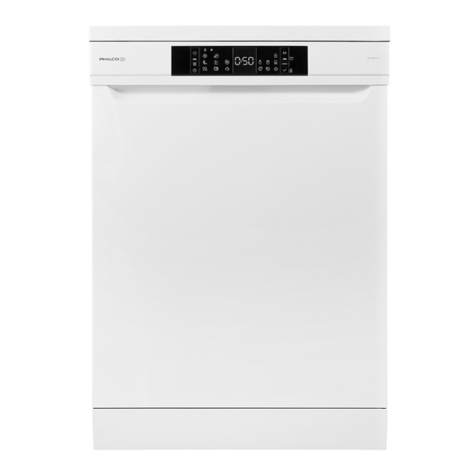
Philco
Philco PDI 1568 DLT User manual
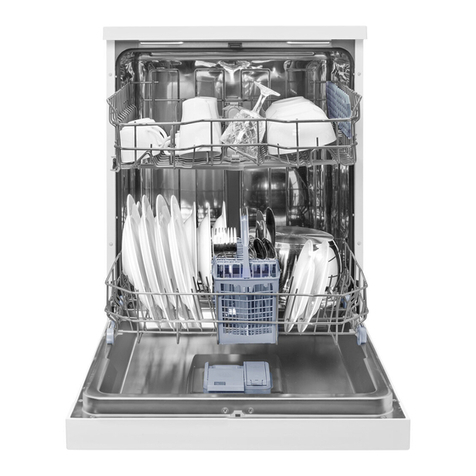
Philco
Philco PD 1266 EA User manual

Philco
Philco PDI 1468 BBIT User manual

Philco
Philco PD 1046 ET User manual
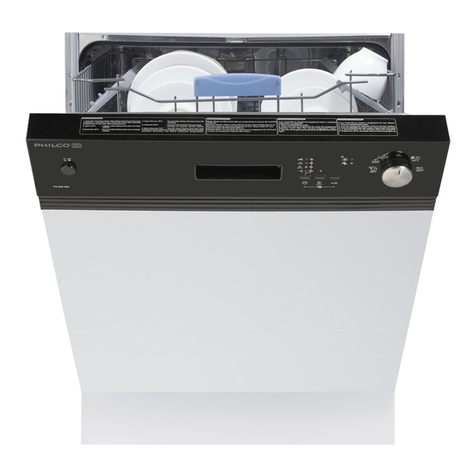
Philco
Philco PD 1261 BiB User manual
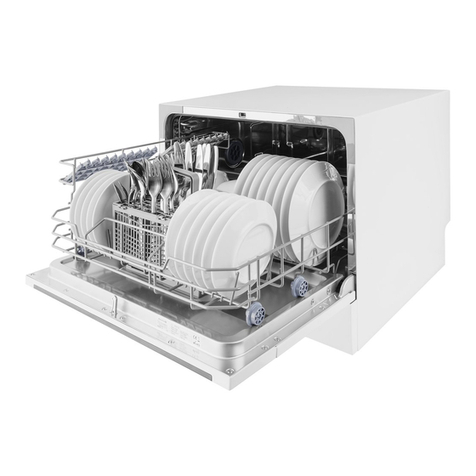
Philco
Philco PDT 671 User manual

Philco
Philco PDT 66 F User manual
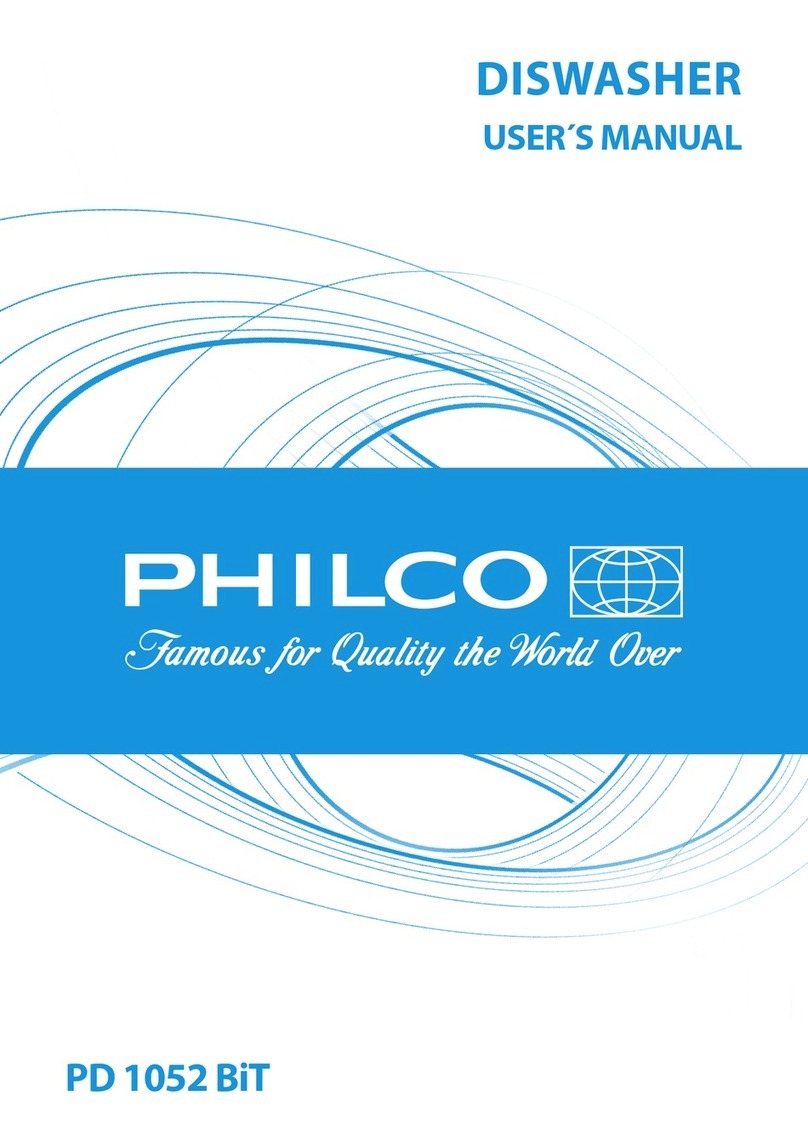
Philco
Philco PD 1052 BiT User manual
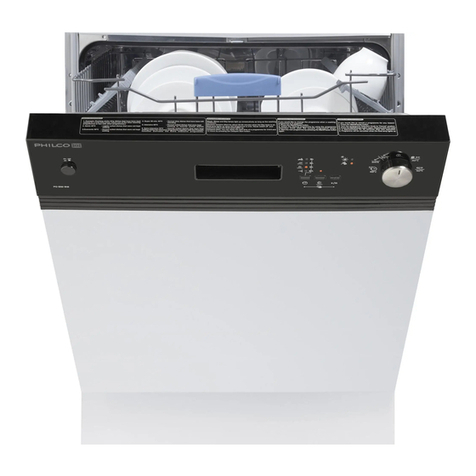
Philco
Philco PD 1261 BiB User manual
